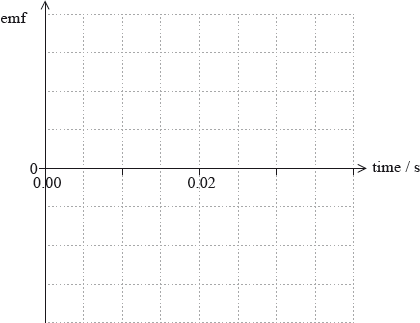| Date | May 2014 | Marks available | 5 | Reference code | 14M.2.HL.TZ2.5 |
| Level | Higher level | Paper | Paper 2 | Time zone | Time zone 2 |
| Command term | Determine and Sketch | Question number | 5 | Adapted from | N/A |
Question
This question is about generating emfs.
A vertical metal rod of length 0.25 m moves in a horizontal circle about a vertical axis in a uniform horizontal magnetic field.

The metal rod completes one circle of radius 0.060 m in 0.020 s in the magnetic field of strength 61 mT.
Define magnetic flux.
(i) Determine the maximum emf induced between the ends of the metal rod.
(ii) Using the axes, sketch a graph to show the variation with time of the emf of the metal rod.

Markscheme
magnetic flux density/magnetic field strength normal to a surface \( \times \) area of surface;
Allow fully explained equation or diagram.
(i) \(v = \frac{1}{{0.02}} \times 2\pi \times 0.06{\text{ }}\left( { = 18.8{\text{ m}}\,{{\text{s}}^{ - 1}}} \right)\);
\(\varepsilon = (Blv = ){\text{ }}61 \times {10^{ - 3}} \times 0.25 \times 18.8\);
290 (mV);
Award [3] for a bald correct answer.
(ii) sinusoidal curve drawn; (at least half a cycle required)
with a period of 0.02 s;
Accept any phase.
Examiners report
A strong and complete definition was required here. It was often lacking. There were references to “magnetic field” or “magnetic strength”, and the angle between B and was often incorrectly defined. This standard bookwork left a lot to be desired.
(i) A standard error in this calculation was to misunderstand how to determine the speed of the rod. Some credit was allowed if this was incorrect. Many candidates recognised that the emf was related to Blv and the speed determination was their only error.
(ii) Space had been left on the graph for two complete cycles of the wave and this is what examiners expected to see. Very many candidates failed to think the problem through and assumed that the grid axes had been set up for one period. Most candidates realised that there was some sinusoidal behaviour for the emf. However, examiners saw a minority of very strange graphs.

